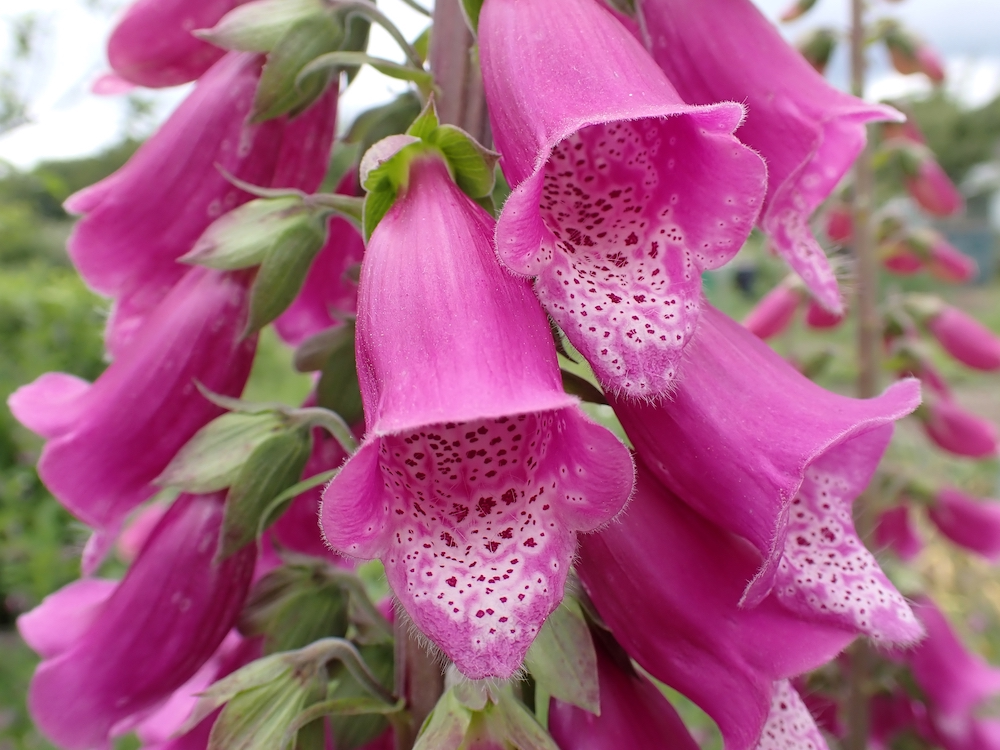
Foxglove
Botanical Name
:
Digitalis purpurea
Plant Type
:
Biennial (sometimes behaves as a short-lived perennial).
Seasons
:
Spring, Summer
Sun Level
:
Full sun to partial shade (4–6 hours of sunlight is ideal).
Ideal Soil Temperature for Planting
:
60–70°F (15–21°C)
Soil Type
:
Moist, well-draining, loamy or sandy soil
Germination
:
14–21 days; requires light for germination.
P.H. Level
:
6.0–7.0
Water/Irrigation
:
Keep soil consistently moist, especially during dry seasons.
Fertilization
:
Regularly balanced fertilizer during the growing season for flowering and growth.
Habit
:
Forms a basal rosette in the first year, then an upright flowering stem in the second year.
Final Plant Height
:
2–5 feet (60–150 cm)
Spread
:
1–2 feet (30–60 cm)
Spacing
:
12–18 inches (30–45 cm)
Flowers
:
Bell-shaped, tubular, pink, purple, white, or yellow blooms with speckled throats.
Attracts
:
Bees, butterflies, and hummingbirds.
Uses
:
Cottage gardens, borders, woodland gardens, pollinator gardens
Companions
:
Ferns, hostas, columbine, delphinium
Pruning
:
Remove spent flower spikes to encourage secondary blooms and prevent self-seeding (unless you want it to naturalize). Cut back foliage after flowering is finished.
Toxicity
:
Highly toxic if ingested; contains cardiac glycosides that can be fatal to humans and pets.
Pests
:
Aphids, slugs, and Japanese beetles can occasionally be a problem.
Diseases
:
Crown rot, leaf spot, and powdery mildew can occur, especially in poorly drained conditions.
Did You Know?
Digitalis purpurea is the primary source of the heart medication digoxin, used to treat heart failure and certain arrhythmias.
Botanical Name
:
Digitalis purpurea
Plant Type
:
Biennial (sometimes behaves as a short-lived perennial).
Seasons
:
Spring, Summer
Sun Level
:
Full sun to partial shade (4–6 hours of sunlight is ideal).
Ideal Soil Temperature for Planting
:
60–70°F (15–21°C)
Soil Type
:
Moist, well-draining, loamy or sandy soil
Germination
:
14–21 days; requires light for germination.
P.H. Level
:
6.0–7.0
Water/Irrigation
:
Keep soil consistently moist, especially during dry seasons.
Fertilization
:
Regularly balanced fertilizer during the growing season for flowering and growth.
Habit
:
Forms a basal rosette in the first year, then an upright flowering stem in the second year.
Final Plant Height
:
2–5 feet (60–150 cm)
Spread
:
1–2 feet (30–60 cm)
Spacing
:
12–18 inches (30–45 cm)
Flowers
:
Bell-shaped, tubular, pink, purple, white, or yellow blooms with speckled throats.
Attracts
:
Bees, butterflies, and hummingbirds.
Uses
:
Cottage gardens, borders, woodland gardens, pollinator gardens
Companions
:
Ferns, hostas, columbine, delphinium
Pruning
:
Remove spent flower spikes to encourage secondary blooms and prevent self-seeding (unless you want it to naturalize). Cut back foliage after flowering is finished.
Toxicity
:
Highly toxic if ingested; contains cardiac glycosides that can be fatal to humans and pets.
Pests
:
Aphids, slugs, and Japanese beetles can occasionally be a problem.
Diseases
:
Crown rot, leaf spot, and powdery mildew can occur, especially in poorly drained conditions.
Did You Know?
Digitalis purpurea is the primary source of the heart medication digoxin, used to treat heart failure and certain arrhythmias.

